Introduction to scrapy crawler framework
Introduce the scrapy crawler framework
Installation method pip install scrapy can be installed. I use the anaconda command to conda install scrapy.

1 Engine obtains the crawling request (Request) from Spider<br>2Engine will The crawling request is forwarded to Scheduler for scheduling
3 Engine obtains the next request to crawl from Scheduler<br>4 Engine sends the crawling request to Downloader through middleware<br>5 Crawl After the web page, the Downloader forms a response (Response) and sends it to the Engine through the middleware<br>6 The Engine sends the received response to the Spider through the middleware for processing. The Engine forwards the crawling request to the Scheduler for scheduling
7 After Spider processes the response, it generates scraped Item<br> and new crawling requests (Requests) to Engine<br>8 Engine sends the scraped item to Item Pipeline (framework exit)<br>9 Engine will The crawling request is sent to the Scheduler
Engine controls the data flow of each module and continuously obtains crawling requests from the Scheduler<br> until the request is empty<br>Frame entry: Spider's initial crawling request<br>Frame export: Item Pipeline
Engine Downloader<br>Download web pages according to requests<br>No user modification required<br>
SchedulerScheduling and management of all crawling requests<br>No user modification required<br>
Downloader MiddlewarePurpose: Implement user-configurable control between Engine, Scheduler and Downloader<br><br>Function: modify, discard, add request or response
User can write Configuration codeSpider<br><br>(1) Parse the response returned by Downloader<br>(2) Generate scraped item<br>(3) Generate Additional crawling requests (Request)
Require users to write configuration codeItem Pipelines<br><br>(1) Process the crawled items generated by Spider in a pipeline manner<br>( 2) It consists of a set of operation sequences, similar to a pipeline. Each operation <br> is an Item Pipeline type
(3) Possible operations include: cleaning, checking and duplication checking of theHTML data in the crawled items , Storing data into the databaseRequires users to write configuration code<br>After understanding the basic concepts, let’s start writing the first scrapy crawler. <br><br>First, create a new crawler project scrapy startproject xxx (project name) <br><br><br>
This crawler will simply crawl the title and author of a novel website. .
We have created the reptile project book now to edit his configuration

This is the introduction of the configuration file. Before modifying these
修 We now create a start.py in the first -level Book directory to use it for the Scrapy reptile to run in the IDE
## noodles. Write the following code in the file.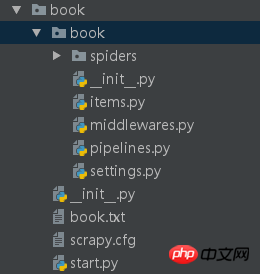 The first two parameters are fixed, and the third parameter is the name of your spider
The first two parameters are fixed, and the third parameter is the name of your spider
Next we fill in the fields in items:

By clicking on the different types of novels on the website, you will find that the website address is +Novel Type Pinyin.html
Through this we write and read the content of the web page
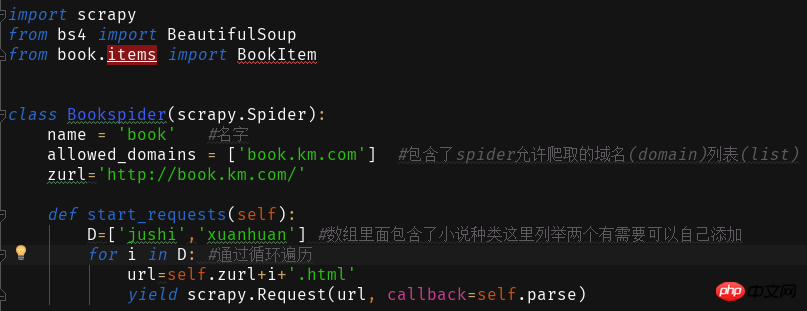
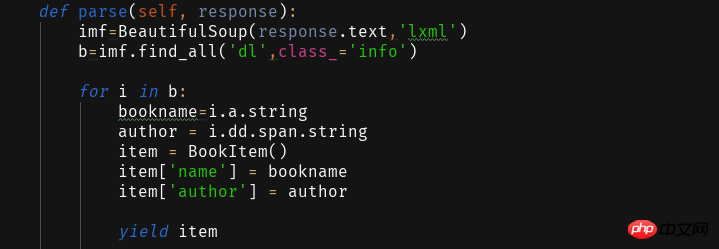
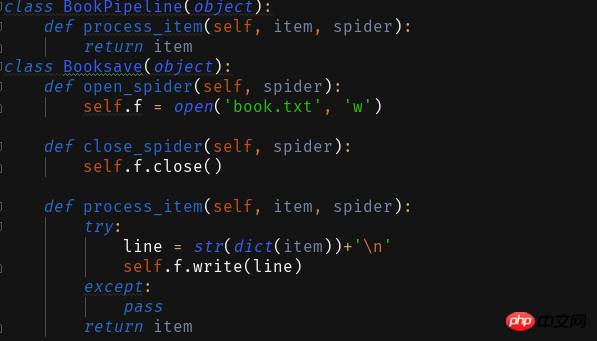
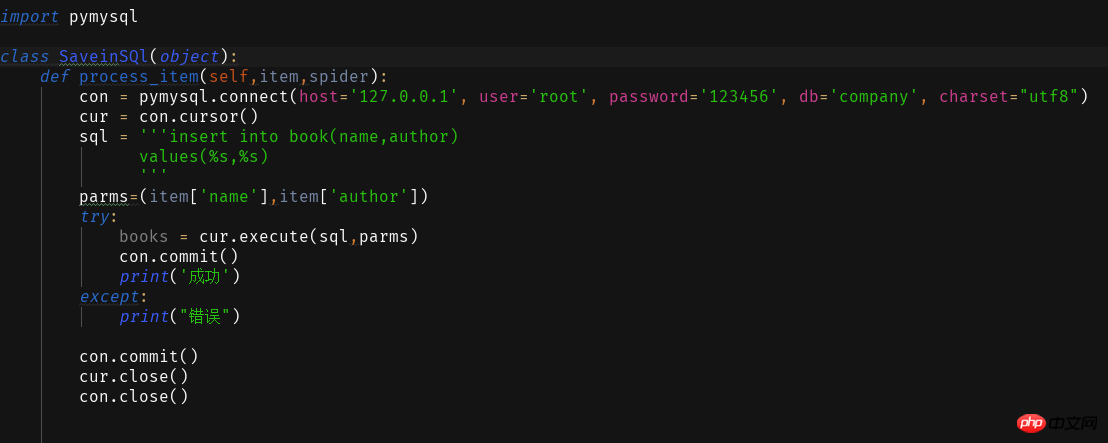
<span style="color: #000000">ITEM_PIPELINES = { 'book.pipelines.xxx': 300,}<br>xxx为存储方法的类名,想用什么方法存储就改成那个名字就好运行结果没什么看头就略了<br>第一个爬虫框架就这样啦期末忙没时间继续完善这个爬虫之后有时间将这个爬虫完善成把小说内容等一起爬下来的程序再来分享一波。<br>附一个book的完整代码:<br></span>import scrapyfrom bs4 import BeautifulSoupfrom book.items import BookItemclass Bookspider(scrapy.Spider):
name = 'book' #名字
allowed_domains = ['book.km.com'] #包含了spider允许爬取的域名(domain)列表(list)
zurl=''def start_requests(self):
D=['jushi','xuanhuan'] #数组里面包含了小说种类这里列举两个有需要可以自己添加for i in D: #通过循环遍历
url=self.zurl+i+'.html'yield scrapy.Request(url, callback=self.parse)
def parse(self, response):
imf=BeautifulSoup(response.text,'lxml')
b=imf.find_all('dl',class_='info')for i in b:
bookname=i.a.stringauthor = i.dd.span.stringitem = BookItem()
item['name'] = bookname
item['author'] = authoryield item<br>
The above is the detailed content of Introduction to scrapy crawler framework. For more information, please follow other related articles on the PHP Chinese website!

Hot AI Tools

Undresser.AI Undress
AI-powered app for creating realistic nude photos

AI Clothes Remover
Online AI tool for removing clothes from photos.

Undress AI Tool
Undress images for free

Clothoff.io
AI clothes remover

Video Face Swap
Swap faces in any video effortlessly with our completely free AI face swap tool!

Hot Article

Hot Tools

Notepad++7.3.1
Easy-to-use and free code editor

SublimeText3 Chinese version
Chinese version, very easy to use

Zend Studio 13.0.1
Powerful PHP integrated development environment

Dreamweaver CS6
Visual web development tools

SublimeText3 Mac version
God-level code editing software (SublimeText3)

Hot Topics
 1670
1670
 14
14
 1428
1428
 52
52
 1329
1329
 25
25
 1274
1274
 29
29
 1256
1256
 24
24
 PHP and Python: Different Paradigms Explained
Apr 18, 2025 am 12:26 AM
PHP and Python: Different Paradigms Explained
Apr 18, 2025 am 12:26 AM
PHP is mainly procedural programming, but also supports object-oriented programming (OOP); Python supports a variety of paradigms, including OOP, functional and procedural programming. PHP is suitable for web development, and Python is suitable for a variety of applications such as data analysis and machine learning.
 Choosing Between PHP and Python: A Guide
Apr 18, 2025 am 12:24 AM
Choosing Between PHP and Python: A Guide
Apr 18, 2025 am 12:24 AM
PHP is suitable for web development and rapid prototyping, and Python is suitable for data science and machine learning. 1.PHP is used for dynamic web development, with simple syntax and suitable for rapid development. 2. Python has concise syntax, is suitable for multiple fields, and has a strong library ecosystem.
 How to run sublime code python
Apr 16, 2025 am 08:48 AM
How to run sublime code python
Apr 16, 2025 am 08:48 AM
To run Python code in Sublime Text, you need to install the Python plug-in first, then create a .py file and write the code, and finally press Ctrl B to run the code, and the output will be displayed in the console.
 PHP and Python: A Deep Dive into Their History
Apr 18, 2025 am 12:25 AM
PHP and Python: A Deep Dive into Their History
Apr 18, 2025 am 12:25 AM
PHP originated in 1994 and was developed by RasmusLerdorf. It was originally used to track website visitors and gradually evolved into a server-side scripting language and was widely used in web development. Python was developed by Guidovan Rossum in the late 1980s and was first released in 1991. It emphasizes code readability and simplicity, and is suitable for scientific computing, data analysis and other fields.
 Python vs. JavaScript: The Learning Curve and Ease of Use
Apr 16, 2025 am 12:12 AM
Python vs. JavaScript: The Learning Curve and Ease of Use
Apr 16, 2025 am 12:12 AM
Python is more suitable for beginners, with a smooth learning curve and concise syntax; JavaScript is suitable for front-end development, with a steep learning curve and flexible syntax. 1. Python syntax is intuitive and suitable for data science and back-end development. 2. JavaScript is flexible and widely used in front-end and server-side programming.
 Golang vs. Python: Performance and Scalability
Apr 19, 2025 am 12:18 AM
Golang vs. Python: Performance and Scalability
Apr 19, 2025 am 12:18 AM
Golang is better than Python in terms of performance and scalability. 1) Golang's compilation-type characteristics and efficient concurrency model make it perform well in high concurrency scenarios. 2) Python, as an interpreted language, executes slowly, but can optimize performance through tools such as Cython.
 Where to write code in vscode
Apr 15, 2025 pm 09:54 PM
Where to write code in vscode
Apr 15, 2025 pm 09:54 PM
Writing code in Visual Studio Code (VSCode) is simple and easy to use. Just install VSCode, create a project, select a language, create a file, write code, save and run it. The advantages of VSCode include cross-platform, free and open source, powerful features, rich extensions, and lightweight and fast.
 How to run python with notepad
Apr 16, 2025 pm 07:33 PM
How to run python with notepad
Apr 16, 2025 pm 07:33 PM
Running Python code in Notepad requires the Python executable and NppExec plug-in to be installed. After installing Python and adding PATH to it, configure the command "python" and the parameter "{CURRENT_DIRECTORY}{FILE_NAME}" in the NppExec plug-in to run Python code in Notepad through the shortcut key "F6".




